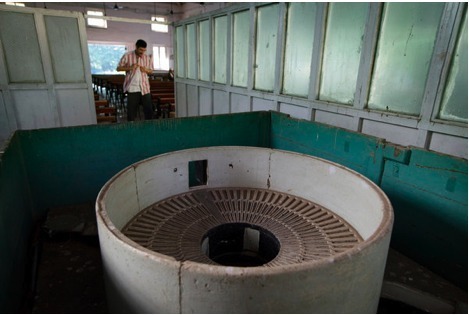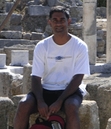This is one of the “Towers of Silence”, in Mumbai,...

This is one of the “Towers of Silence”, in Mumbai, India, in which Parsis (Zoroastrians, descended from ancestors who fled Iran in the 10th century and settled in Bombay) place bodies for disposal by vultures. This photo is taken from an article that appeared in the New York Times yesterday, about the problems Parsis are having because the population of vultures is dwindling to the point where there aren’t enough of them to consume the bodies. This is forcing the Parsis to turn to cremation, which violates their beliefs. Click on the photo to read the fascinating story.
In my novel, “The Blind Spot”, I have this conversation between two characters, one an Indian who has moved from his native Delhi to Mumbai, and another, an Indian-American, who has recently relocated to Mumbai, both working at the same company.
——————————————————————————————
A few yards down the road, we came upon a biscuit-colored entrance archway that must have been a good five storys high, presaging what appeared to be a large compound of buildings and lush foliage. The black gates were thrown open.
“Cusrow Baug,” I said aloud, reading the sign above the arch. “Buildings for Parsees.” I turned to Rajiv. “Who are Parsees?”
“Persians—Zoroastrians—who fled Iran to escape Muslim persecution, and landed in Bombay.” He was gazing at the arch, wearing a distant look. “Hundreds of years ago.”
“They have their own exclusive neighborhoods, like gated communities?”
He turned to me. “There a few. This one is the most well known. There aren’t too many of them, so they like to stick together. Also, they very rarely marry outside their community. We call them bawas.”
“Why?”
“No idea.” He shrugged. “It’s this thing, like gujju, for Gujaratis, or madrasi, for anyone who is from south India. Of course those terms have obvious origins, but…” He paused, brows furrowed. Then added, “I don’t think bawa is used outside of Bombay. To be honest, I am not sure people outside of Bombay even know of Parsees.”
This piqued my curiosity. I had never heard of Parsees before this, and Rajiv seemed more than willing to indulge me. As a matter of fact, all this talk of Parsees seemed to have lit a spark in him.
“Tell me more,” I said, as we resumed walking up the Causeway.
His face lit up. “Ah, I see you are getting into it. Ok, a couple of remarkable Parsee facts that every Bombayite knows. First: they pray at what are called fire temples. The unusual thing is that the temple is actually a well, with a fire burning inside.”
He must sensed some disbelief in my reaction. “There’s one in Churchgate,” he said quickly. “I’ll show you on our way back.”
“All right, fact one filed away. And the other thing?”
“Oh yes, the second one is… even more remarkable. Parsees don’t bury their dead.”
I wasn’t sure why this was a big deal. “So they cremate them?”
He shook his head. I raised my eyebrows.
“They leave the body out, to be picked clean by scavenging birds.”
Now he had be spellbound. “Really?”
He nodded. “There’s this place called the Tower of Silence in Malabar Hill, not too far from here, where they put out the bodies. A kind of clearing in the woods, high above the city. You can’t see it from the outside, it’s pretty well hidden. Only Parsees are allowed in, of course.”



